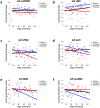Neuroanatomical Correlates of Childhood Stuttering: MRI Indices of White and Gray Matter Development That Differentiate Persistence Versus Recovery
- PMID: 31465710
- PMCID: PMC6813035
- DOI: 10.1044/2019_JSLHR-S-CSMC7-18-0356
Neuroanatomical Correlates of Childhood Stuttering: MRI Indices of White and Gray Matter Development That Differentiate Persistence Versus Recovery
Abstract
Purpose We review two recent neuroanatomical studies of children who stutter (CWS), one that examines white matter integrity and the other that focuses on cortical gray matter morphology. In both studies, we sought to examine differences between children whose stuttering persists ("persistent"), children who recovered from stuttering ("recovered"), and their nonstuttering peers ("controls"). Method Both of the reviewed studies use data from a large pediatric sample spanning preschool- to school-age children (3-10 years old at initial testing). Study 1 focused on surface-based measures of cortical size (thickness) and shape (gyrification) using structural magnetic resonance imaging, whereas Study 2 utilized diffusion tensor imaging to examine white matter integrity. Results In both studies, the main difference that emerged between CWS and fluent peers encompassed left hemisphere speech motor areas that are interconnected via the arcuate fasciculus. In the case of white matter integrity, the temporoparietal junction and posterior superior temporal gyrus, both connected via the left arcuate fasciculus, and regions along the corpus callosum that contain fibers connecting bilateral motor regions were significantly decreased in white matter integrity in CWS compared to controls. In the morphometric study, children who would go on to have persistent stuttering specifically had lower cortical thickness in ventral motor and premotor areas of the left hemisphere. Conclusion These results point to aberrant development of cortical areas involved in integrating sensory feedback with speech movements in CWS and differences in interhemispheric connectivity between the two motor cortices. Furthermore, developmental trajectories in these areas seem to diverge between persistent and recovered cases.
Figures





References
-
- Barnea-Goraly N., Menon V., Eckert M., Tamm L., Bammer R., Karchemskiy A., … Reiss A. L. (2005). White matter development during childhood and adolescence: A cross-sectional diffusion tensor imaging study. Cerebral Cortex, 15, 1848–1854. - PubMed
-
- Brody B. A., Kinney H. C., Kloman A. S., & Gilles F. H. (1987). Sequence of central nervous system myelination in human infancy. I. An autopsy study of myelination. Journal of Neuropathology and Experimental Neurology, 46, 283–301. - PubMed
Publication types
MeSH terms
Grants and funding
LinkOut - more resources
Full Text Sources
Medical

